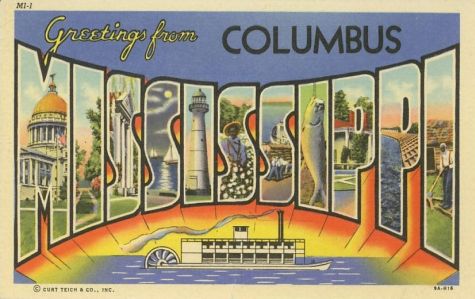Content taken from http://www.thecityofcolumbusms.org/
Columbus is situated at the juncture of three rivers: the Tombigbee, The Buttahatchie, and the Luxapalila. Hernando de Soto crossed the Tombigbee River in 1540 into this area. William Cooper had a trading post near here in the 1780’s. Columbus has managed to progress as a city, while still honoring those who came earlier and forged a path. Since before the town was chartered in 1821, men and women of character and intellect had already staked their claim on the area. At that time, the still-new United States was offering land grants to anyone who could work the land. United States military officers came through here during the War of 1812, and some decided that someday, they would return to this lush and lovely land. A few did return, and built the plantations Goshen, Belmont and others after they cleared wilderness for homesites.
From the early days, education has been a pivotal force in Columbus. In 1821, the first public school in the state was started here, and Franklin Academy is still going strong today. By 1830, the Treaty of Dancing Rabbit Creek opened up more land for settlement, and some of the landed gentry from the cotton-depleted East Coast states came here because of the rich Black Prairie soil. They began to build the grand mansions to provide comfort and safety for their families — and to reflect their prosperity.
Economic depressions in 1836 and again ten years later brought ruin to some planters, though fortunes were made by others. Columbus was, by the 1850s, a boom town. Cotton production was flourishing, with planters now learning about the necessity of crop rotation and diversification.
By 1860, states’ rights had taken control of the thoughts and actions of many Mississippians, and the nation was on the verge of a civil war. The North had industry; the South had agriculture and the war began. Mississippi seceded from the Union on January 9, 1861. The American Civil War lasted until 1865, when Southern soldiers returned to a homeland they hardly recognized.
In 1866, a group of Columbus women met in the home Twelve Gables to decide on a way to honor the Confederate war dead in the local Oddfellows Cemetery. They decided on a date to meet, walk to the cemetery and decorate the graves with flowers from their gardens. Once they arrived, one of the women began placing flowers on the graves of the few Union soldiers, too, for they also had given their lives for their beliefs. Other women followed suit, and soon, all the graves — Confederate and Union — had flowers. This generous gesture was told and re-told, and finally made its way to the New York Tribune, where the short article was seen by young attorney Francis Miles Finch. He was so moved by the generosity of the Southern ladies and their Decoration Day, he wrote the poem, “The Blue and the Gray,” and it was published in the Atlantic Monthly in September 1867.
Other towns claim Decoration Day, perhaps earlier than the one in Columbus, but Columbus was the first to honor former enemies. Here’s what the Library of Congress said: “Columbus, Mississippi, thus, can rightly claim to be not only one day ahead of Columbus, Georgia, in its observance of Memorial Day, but more generous in its distribution of the tributes of honor
and mourning.”
What began as a solemn occasion in Columbus in April 1866 has evolved into the nation’s Memorial Day, now officially observed each May. The Union soldiers were later moved to a national cemetery, and Columbus went about rebuilding its spirit as well as the economy. A new South was emerging, and Columbians changed with the times.
The nation’s first state-supported college for women was organized in 1884 and the city settled into a life of culture and prosperity.
Columbus is also the birthplace of playwright Tennesse Williams, whose home is now the Welcome Center on Main St.
The African-American community found its niche and prospered, too. Former servants developed their own businesses and civic life from the part of town known as “Catfish Alley,” which is actually a block on 4th Street South between College Street and Main Street. According to the late Dr. E.J. Stringer, a local civil rights leader, politician, minister and dentist, Catfish Alley was the hub of activity for rural blacks who came into town to sell fresh vegetables and the catfish they caught along the way.
Dr. Stringer said in a previous interview: “Long before the 1940s, there were provisions to either sell the catfish uncooked, or cook it on the spot and sell it by the plate. When it was cooked, the aroma of the catfish filled the air, thus the name ‘Catfish Alley’. As long as I can remember, Catfish Alley served as a place where laborers gathered for transportation provided by employers, and it was a place where people congregated to talk and to exchange news and ideas. It was the site of black-owned businesses and professional offices, and a place for people who made a difference in the black community.” Dr. Stringer, who once had his dental office in “The Alley”, said that his greatest desire was to see people get along; to achieve oneness of community. He died in 1995.

